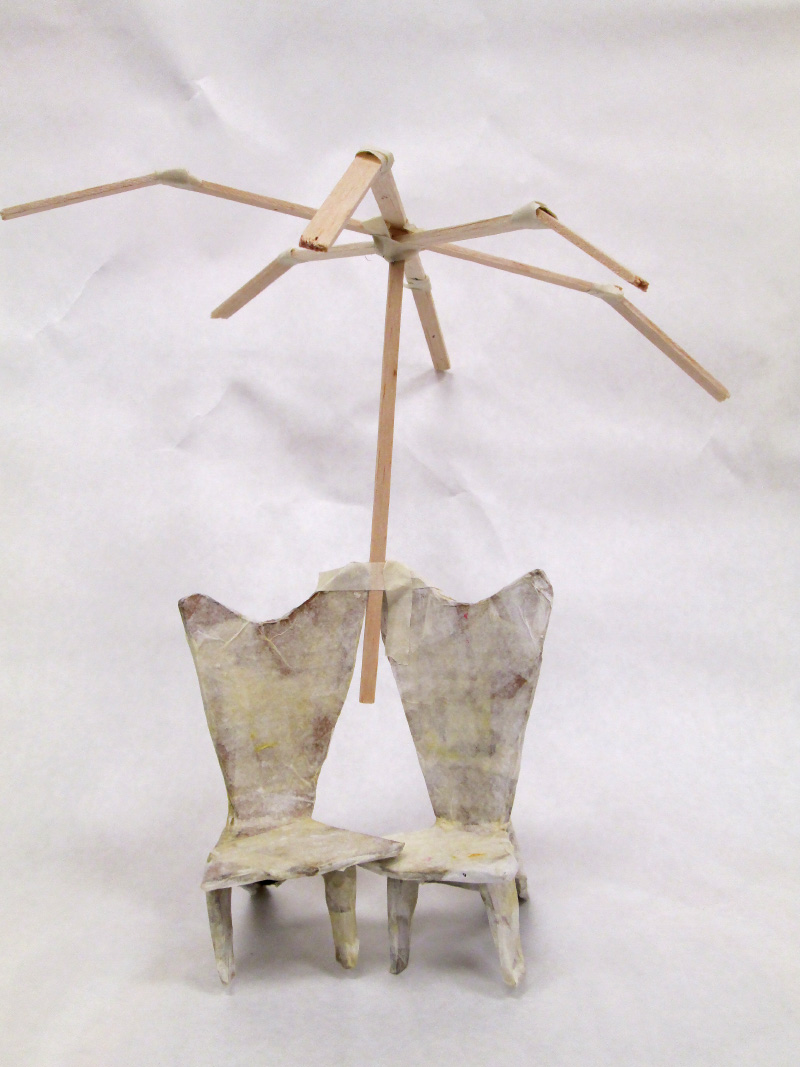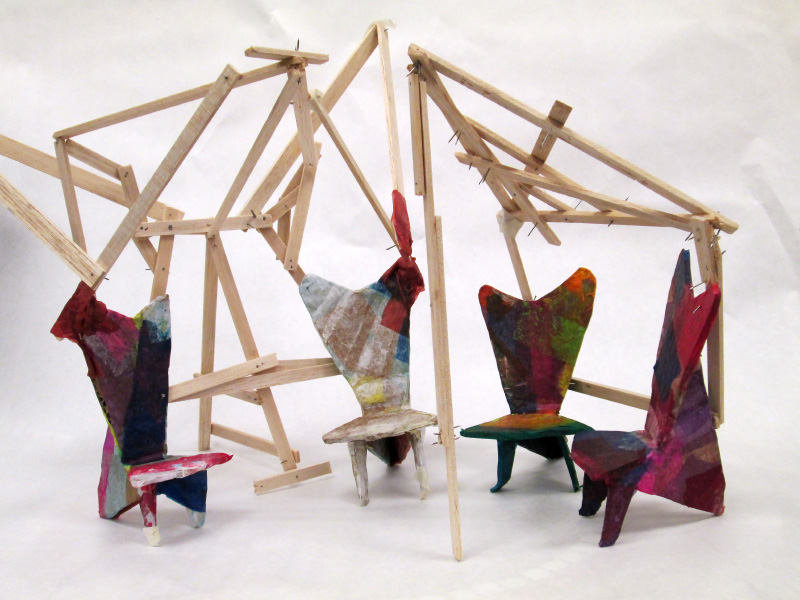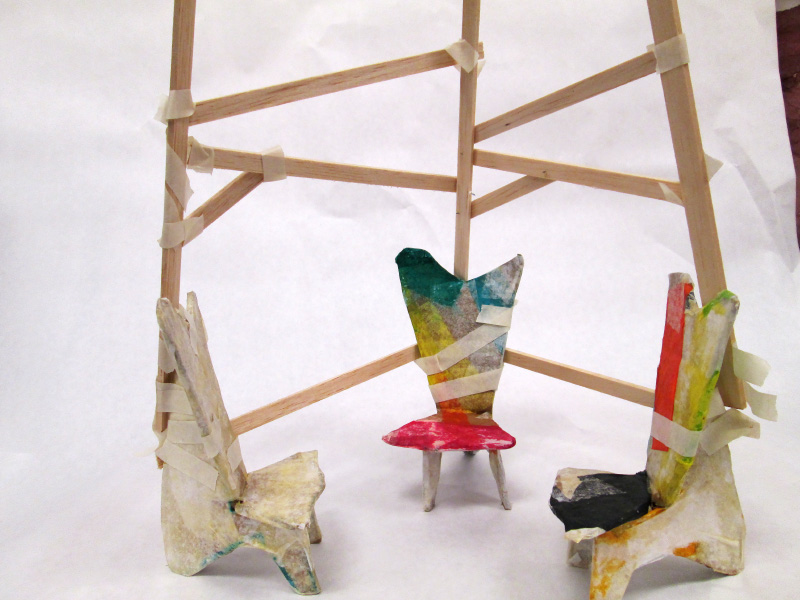
Influenced by Doris Salcedo and her work with salvaged material installations that addressed issues of civil war, loss, invisibility, and oppression, we are creating diad and triad seating sculptures that represent “a safe space for difficult conversations.” In an immigrant community, some of these difficult conversations might include issues of immigration and being first- or second-generation Americans. Students endure a great deal of stress straddling two worlds; the world of their parents and their homeland, living up to the sacrifices their families have made to come here, and the invisible pressures of being an immigrant teen of color in America, who is suddenly supposed to be “American,” go to college, and exemplify the American dream. Who do they turn to to talk about these challenges, what are the right words, where is the path to success?
- Students will explore the work of artists who address issues and challenges in their communities.
- Students will develop sculptures and installation art that integrate issues and challenges in their communities.
Documentation + Assessment Suggestions
We photographed the work, from creating models to attaching the chairs together, to adding structures above and around the chairs in order to reinforce the sense of safety.
Students worked as teams developing our artists’ statement using a graphic organizer. A compilation statement was drafted, and given a final review by the class. Does this statement capture what we are trying to do? Does this statement capture what this project is about?
Students worked as teams developing a rubric. Each team developed descriptors for standards-based criteria that demonstrated mastery. Each criterion was presented to the class, who had an opportunity to gallery-walk and add refinements to descriptors.
Learning Activities
Discuss… I like America and America Likes Me, an action orchestrated by Joseph Beuys to better understand the history of indigenous cultures and how identity is constructed through policy and laws.
Design… 1”-1’ scale models using cardboard chairs and balsa wood, to better understand what construction challenges exist to make these Safe Space structures.
Combine 2-3 chairs using 1 x 2’s and 1 x 4”s, hardware, ½” and ¾” screws.
Photograph… the steps involved.
Investigate… the work of Doris Salcedo, to understand how artists use research and teamwork to create socially relevant work.
Complete… graphic organizer to think about the purpose and intention behind the Safe Space project. Why do we need a Safe Space?
Install… the seating in areas that will be dedicated to students and community access to further question, dream, and express themselves about challenges and solutions.
Replicable activities:
Creating scale models to problem solve and develop designs.
Developing a group Artist Statement
Developing a Group Rubric based on Studio Habits of Mind, specifically:
- Understanding the Art World, working with artists and working as an artist
- Developing Craft, attention to detail, and care of studio
- Stretch and Grow, experimenting and problem-solving.
- Developing conversations between generations as a duet poem that travels back and forth between life-changing events
- Integrating the stories and honoring ancestors as inspiration for surface designs of the sculpture.
We created model versions of the diad and triad seat sculptures in 1” to 1’ scale. This process was exceedingly helpful in determining real world challenges and coming up with solutions that helped to figure out our materials (wood, hardware, and ways to attach the chairs that made strong structures).
I experimented in covering chairs in concrete, which looked wonderful, but it proved to not be a good solution due to exacerbating wet conditions. So, I did some research and found a material called Blue Max, an elastometric rubber material that is used to waterproof concrete, wood, and brick. I considered it well worth a try, even though it is kind of expensive. So, I covered 5 of the concrete chairs that are part of the experiment. This stuff takes FOREVER to dry. Weeks. It did eventually get dry, but only in patches so far. I am kind of shocked at the length of time it is taking to cure. But, it looks like this kind of glowy blue surface, and as far as surface goes, I like the look. It gives concrete a rubbery surface, making it softer, which is a nice combination.
I am weaving together new artists I am learning about (John Preus, Doris Salcedo) with past contemporary artists I have long admired: Joseph Beuys, William Kentridge, and Thomas Hirschhorn.

Materials + Supplies
- Wooden Chairs. (we used 30)
- 75 pieces of 1 x 2” x 8’. 15 10’ ¼ “ steel rod
- 3/4” pink rigid foam
- ½”, ¾”, 1 ¼” screws
- Fiber tape and papier mache for joints
- Exterior paint in bright colors
- Blue Max waterproofing
MCA Connections
We visited the Doris Salcedo retrospective to understand how artists construct socially meaningful art. Our reflection was the jumping-off place for creating an artist statement about what we were trying to say about the need for a safe space for youth and our community.
Resources
Jeanne Walker
John Hancock College Prep
Jeanne Walker has been a Visual Arts Teacher for 16 years. Jeanne is passionate about integrating civic engagement and art, and about teaching students to use the arts as a way to make change and achieve social justice. Making change is a big job, and Jeanne learned long ago that to have a real impact, you need community partners and allies. This outreach has been a big part of her mission and vision as an educator.
This work has resulted in several awards, including CPS Service Learning Coach of the Year (2011), Golden Apple Teacher of Distinction (2010), Chicago Fund for Teachers Grant in 2008 as co-leader of a cultural exchange in Rwanda, and in 2013 to receive training with Grameen Bank in Bangladesh around the concept of microfinance and social business. These awards represent support and collaboration from alliances such as Mikva Challenge, American Friends Service Committee, Between Friends, Blocks Together, Youth Guidance, Youth Service Project, Chicago Coalition for the Homeless, and more. Teaching in a high-poverty high school offers many challenges, as well as the opportunity to grow more compassionate and open-hearted.
Jeanne reflects on her creative process:
The MCA Teacher Institute offered me the opportunity to expand my practice with further exposure to contemporary artists, particularly the work of Colombian artist Doris Salcedo, who used the conflict and violence of civil war as inspiration for creating installations that were both political and elegant, provocative, searingly thoughtful, and powerful.
The Safe Space Project is an opportunity to learn about immigration issues and the challenges that my students face in adapting to American culture while still holding their country of origin in their hearts. This is their artist statement about our work together:
We will create a safe space for difficult conversations in order to solve problems, to offer everyone courage to express themselves and speak up. We need a space to feel comfortable and open up to each other.
This safe space is dedicated to memories, past, present and future; to family, to our community, and to our friends. May we develop our power and our voice, to discuss and plan and dream a better world, as we solve difficult situations, and make sense of our experiences.
We have created Upstander Furniture to honor those who help others, who offer support through hardship and challenges. In turn, we need to forge our own Upstander path.
I was fortunate to be invited to be a partner school with MCA, which I considered a very big honor. I have been incorporating civic engagement into my art teaching for several years, and now I cannot see it any other way; it is such a part of how I think. My goal was to learn about artists and work with artists who are farther along on this continuum.
I will be honest, I think this year I expanded farther and deeper than ever before, in terms of how I think of partnering with allies and artists, and in terms of how art can be used to make change in a school community.
I like to do art and activism. Many students have not experienced this type of artmaking, and they often wonder: How is this art? Why are we having these conversations about issues and creating solutions? Why aren’t we just drawing? Being able to expose them to artists who are looking at issues in the community, and using art to navigate and explore these issues, offers them a real world experience of contemporary art.
I think teaching is an art form. My model for this thinking is Joseph Beuys, who looked at art and creativity and education as forms of freedom. Paulo Friere looked at education as linked to freedom. Education right now feels like anything but freedom. It is interesting to be an artist and a teacher, especially now, with so much pressure to not think outside of the box, but to fit in the box, follow rules, get evaluated on ideas that were never meant as evaluations, and to question this, to think politically in an art class, has its challenges.
